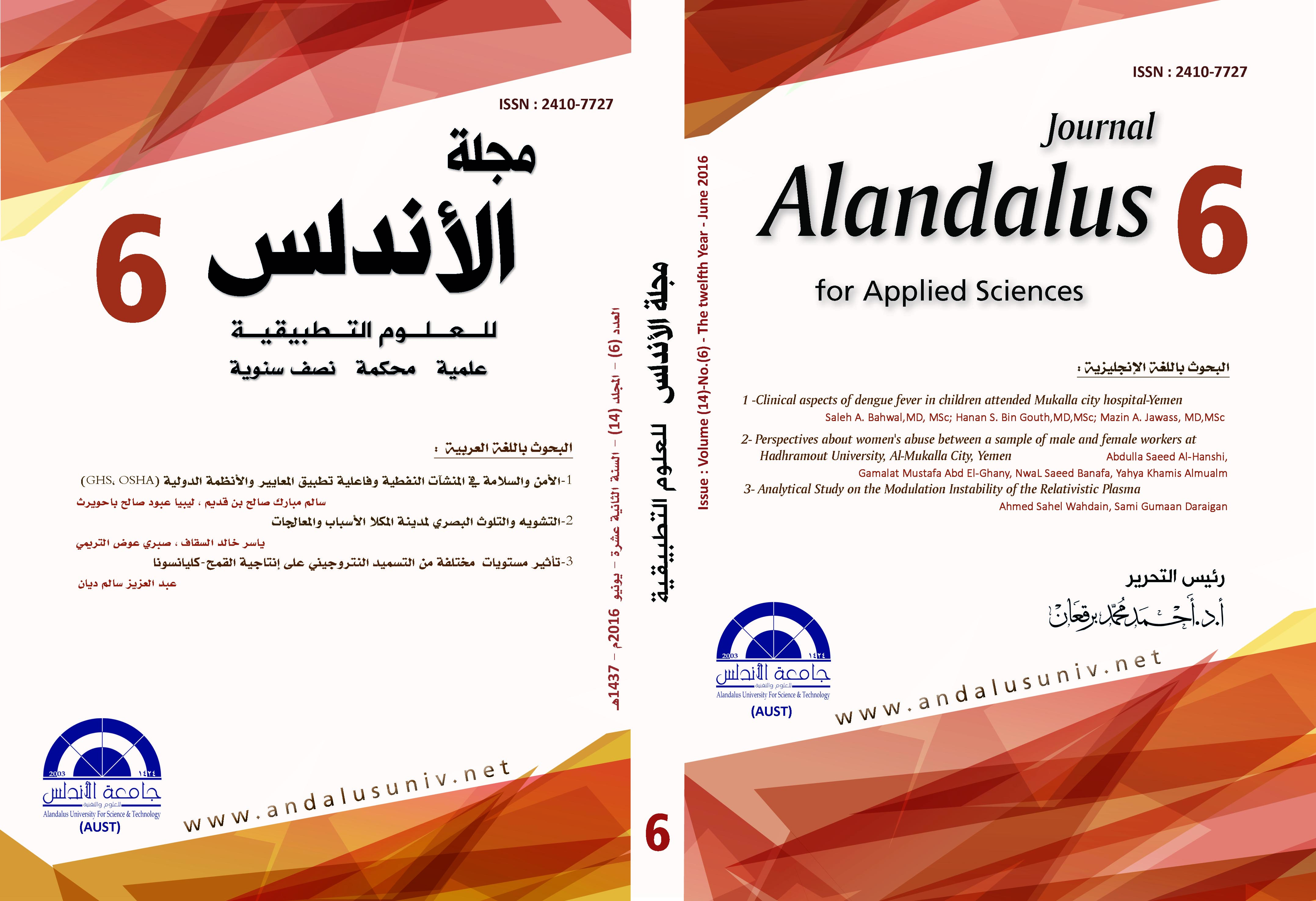الجوانب السريرية للأطفال المصابين بحمى الضنك المترددين على مستشفى مدينة المكلا-اليمن Saleh A. Bahwal,MD, MSc;Hanan S. Bin Gouth,MD,MSc; Mazin A. Jawass, MD,MSc
محتوى المقالة الرئيسي
الملخص
Dengue fever is a mosquito-bome disease that is spread rapidly in new governorates in Yemen in last ten years.
Objectives:The aim of this study was to assess the clinical profiles of children involvement by dengue virus attended Mukalla city hospital, Mukalla,Yamen from January 2015 to December 2015.
Study Design.This cross-section study consisted of 100 children with age range from 6months -14 years ( mean age +/-SD, 9.76 ± 3.64 years) who serologically confirmed to have dengue attended Mukalla city hospital.
A detailed symptomatology, clinical findings,and investigations were recorded.
The patients were divided into three groups according to revised World Health Organization 2009 criteria,dengue fever without warning signs (Group D), dengue fever with warning signs (Group DW) and severe dengue (Group SD).
Results: Out of 100 dengue cases, 60% patients were male and 40% were females (P < 0.05).
The majority of the dengue cases were found in the age group of 11- 14(46%).
The percentage of dengue cases was significantly higher in urban compared to rural (56% versus 44%,P<0.05).
The highest percentage of cases were found to be DW (60%), followed by D 25% and SD (15%).
All patients suffered from fever (100%).
Persistent vomiting was present in 22(36.7%) of group DW and 10 (66.7%) of group SD (P < 0.05).
Abdominal pain was significant higher in group DW (n=45, 75 %) and group SD (n= 13, 86.7 %) compared to group D (n=3, 12 %) (P < 0.05).
Jaundice was observed present in 1 (1.7%) of Group DW and 3 (20 %) of Group SD (P < 0.05).Hepatomegaly was observed present in 18 (30%) of Group DW and 9 (60 %) of Group SD (P < 0.05).
Ascites and pleural effusion were significant higher in group SD (n =4, 26.7 % and n =5, 33.3%,respectively) compared to group DW (n=3, 5% and 4, 6.7 %,respectively)(P< 0.05).
Dyspnoea was observed present in 3 (5%) of Group DW and 2 (13.3%) of Group SD (P > 0.05).Shock was present only in SD (n=2, 13.3%).
Lethargic and restlessness were observed only in group DW (n=15, 25%) and group SD (n=5, 33.3 %)(P< 0.05).
Impairedconsciousness was present only in SD (n=3, 20 %).
The mean platelet count level of the patients were 95.80±77.79, 57.66±47.06,41.62±21.69, in groups D,DW and SD, respectively (P<0.05).
Thrombocytopenia at level of 41-50,000 were found in 6(24% )of group D and 28(46.7%) of group DW compared to 8(53.3 %) of group A (P<0.05).
For patient with groups D,DW, and SD, mean Aspartate Transaminase (AST) values were, 55.50±14.40, 80.00±15.80 and 130.00±15.80 respectively (P<0.05) and mean Alanine Transaminase (ALT) values were, 47.90±10.30, 76.10±11.60,and 110.00±11.80 respectively (P < 0.05).
From 100 specimens were positive for primary infection IgM 20 (20%) and 80 ( 80%) specimens were positive for secondary infection, (IgM and IgG ).It was found out that persistent vomiting (OR 5.72, 95% CI 1.76 to 18.60, p- value 0.
0.003), Abdominal pain (OR 5.01, 95% CI 1.06 to 23.58, p- value 0.041), jaundice (OR 21, 95% CI 2.01 to 218.58, p-value 0.01), hepatomegaly (OR 5.58, 95% CI 1.75 to 17.75, p-value 0.003) and ascites (OR 9.93, 95% CI 1.95 to 50.42, p-value 0.005), and pleural effusion (OR 10.12, 95% CI 2.32 to 44.02, p-value 0.002).
were more significantly associated with severe dengue.
Conclusions: Male sex and children 11- 14 years were most affected by dengue fever with the majority of cases from urban areas.
Persistent vomiting, abdominal pain, jaundice, hepatomegaly, ascites, pleural effusion and hepatomegaly were found significantly high in severe dengue cases which can be used as possible markers of severe dengue.
Keywords:Child, Dengue, Revised classification, Warning signs, World Health organization.
